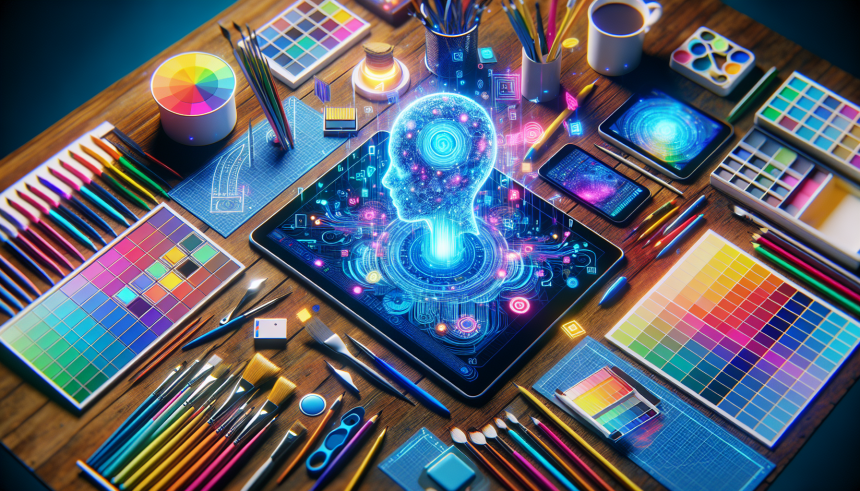AI for Graphic Design: Tools That Transform Visual Content Creation
Understanding AI in Graphic Design
Artificial Intelligence (AI) is increasingly becoming a pivotal element in graphic design, transforming how designers create and interact with visual content. By leveraging sophisticated algorithms and machine learning techniques, AI tools streamline workflows, enhance creativity, and ensure consistency across projects. These innovations are particularly beneficial in an age where quick turnarounds and high-quality output are paramount.
Key Advantages of AI in Graphic Design
-
Efficiency and Time-Saving
AI tools significantly reduce the time spent on mundane tasks. For instance, automatic image enhancement features can quickly adjust brightness, contrast, and color saturation. This allows designers to focus more on creative aspects rather than time-consuming adjustments. -
Personalization and Customization
AI algorithms analyze user data to offer personalized design recommendations. This capability is particularly useful for companies looking to create tailored marketing materials that resonate with specific demographics. -
Predictive Analytics
AI helps in predicting design trends by analyzing vast amounts of data from various platforms. This predictive power enables designers to stay ahead of market trends and consumer preferences. -
Collaboration and Communication
Many AI tools integrate collaboration features that streamline the feedback process. Real-time collaboration ensures that team members can provide input instantaneously, enhancing teamwork and productivity.
AI-Powered Tools Transforming Graphic Design
-
Adobe Sensei
Adobe Sensei is an AI-driven technology integrated into Adobe Creative Cloud applications. It offers features like auto-tagging of images, improved selection tools, and content-aware fill. For instance, designers can quickly remove unwanted elements from images or adjust layouts based on intelligent suggestions, significantly speeding up the design process. -
Canva
Canva uses AI to simplify graphic design for non-designers. Its intuitive interface is enhanced with features like Magic Resize, which automatically adjusts the dimensions of designs to fit various formats. The Smart Layout feature employs AI to recommend design elements and arrangements, helping users create visually appealing graphics effortlessly. -
DeepArt
This AI-powered tool allows users to transform photos into artwork inspired by famous painters and artistic styles. Using neural networks, DeepArt can apply styles like Impressionism or Cubism to images. This is especially beneficial for artists looking for creative inspiration or for brands aiming to create unique visual content. -
Looka
Looka combines AI and design to help entrepreneurs create logos. Users input their preferences, such as color schemes and styles, and Looka generates multiple logo options. This tool speeds up the branding process for businesses, especially for those with limited budgets or design skills. -
Designhill
Designhill offers an AI logo maker that provides instant logo designs based on a brief questionnaire. Users receive multiple logo concepts quickly, allowing for immediate feedback and iterations. This democratizes graphic design, making it accessible for small businesses and startups. -
Runway ML
Runway ML is a creative suite that utilizes machine learning for various aspects of design, including video editing and animation. Its features include background removal, style transfer, and real-time collaboration. By applying AI to video content creation, designers can produce high-quality outputs with minimal effort. -
Artbreeder
Artbreeder uses AI to merge images and generate new designs. Users can control various aspects of artwork, such as color and style, through simple sliders. This tool is ideal for unleashing creativity, enabling designers to explore infinite variations of a design. -
Visme
Visme leverages AI to assist in creating infographics, presentations, and social media graphics. Its template library, enhanced by AI recommendations, provides users with tailored design choices based on their content. Visme makes it simple for anyone to produce professional-looking graphics. -
Stencil
Stencil is an AI-powered graphic design tool fine-tuned for social media and marketing campaigns. It offers a rich library of stock photos and templates. The ‘Magic Resize’ feature instantly formats any design for various social platforms, saving time for marketers and designers alike. -
Snappa
Snappa is focused on simplifying the process of creating online graphics. With its user-friendly interface, Snappa utilizes AI to suggest design elements and templates based on the project’s purpose. This tool is ideal for marketers and small business owners who require quick and effective graphic solutions.
Challenges and Considerations
While AI tools pave the way for innovative designs, there are challenges to consider. The reliance on algorithms may lead to concerns about originality, as many designs created through templates can start to look similar. It’s crucial for designers to infuse their unique style and creativity into AI-generated components. Additionally, an over-dependence on AI could stifle the creative process, making it vital for designers to strike a balance between using AI tools and preserving their artistic instincts.
The Future of AI in Graphic Design
The future of graphic design appears to be increasingly intertwined with AI advancements. As machine learning continues to improve, AI tools will likely become more intuitive and personalized, offering designers even greater assistance. AI could enable real-time adjustments to designs based on user interaction or feedback, transforming how designers approach projects.
Emerging trends such as augmented reality (AR) and virtual reality (VR) design will also benefit from AI integration. AI can help create dynamic experiences, enhancing user engagement and providing immersive environments for brand storytelling.
As designers adapt to these changes, the role of human creativity will remain indispensable. While AI tools streamline processes and enhance creative potential, the unique insights and emotional narratives that designers bring to projects cannot be replicated by machines alone.
The integration of AI in graphic design is more than just an enhancement; it represents a significant evolution in how visual content is created, styled, and delivered. The tools available today empower designers to explore new frontiers, pushing the boundaries of creativity while making the design process more efficient and accessible than ever before. Embracing these AI tools is not just advantageous but essential for staying relevant in the rapidly evolving landscape of graphic design.


